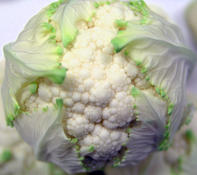Crop Rotation
Plant legumes before planting cauliflower. Follow with a cover crop then follow this with a plant from the tomato family.

If the soil is used more regularly to produce the same crop types, then risk mitigation with strict crop protection programmes and it is advisable to implement soil fumigation practices.
Ensure that the soil is well enriched with compost. Yield (tonnes per hectare) Conservative: 12 tonnes Average: 18 tonnes Good: 25 tonnes
Harvesting
Harvesting of cauliflower is mostly done by hand using sharp knives to harvest the head/curd by cutting the stem just above the ground and including some of the surrounding leaves for protection of the head or curd.
There are harvest assist machines that assist with the conveying of the cauliflower from the field to be packed. As the picking of cauliflower is selective and the heads are sensitive this is done mostly by hand and there are not as yet machines that are able to “smart pick”. As technology improves, there are advances underway in building smart picking machines.
Currently, however, this is a labour intensive, expensive process. The fewer times it is necessary to return to the field for cropping, the more affordable this becomes.
Therefore, the more uniform the crop is, the higher the percentage of the crop the first pick will represent. Once picked, remove cauliflower to a cool place for further handling or storage. Treat the heads or curds with care as any damage leads to marks and decay that will render the product less marketable.